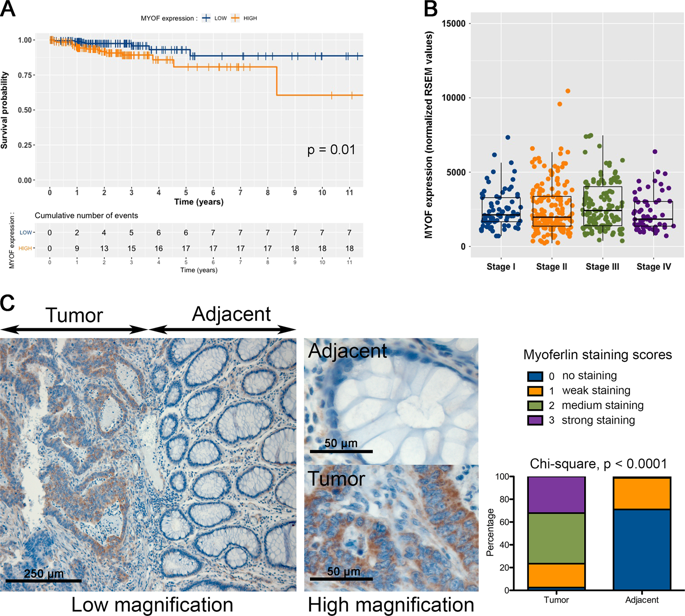Oncogenesis ( IF 6.2 ) Pub Date : 2019-03-08 , DOI: 10.1038/s41389-019-0130-6 Gilles Rademaker 1 , Brunella Costanza 1 , Justine Bellier 1 , Michael Herfs 2 , Raphaël Peiffer 1 , Ferman Agirman 1 , Naïma Maloujahmoum 1 , Yvette Habraken 3 , Philippe Delvenne 2, 4 , Akeila Bellahcène 1 , Vincent Castronovo 1 , Olivier Peulen 1

|
Colon adenocarcinoma is the third most commonly diagnosed cancer and the second deadliest one. Metabolic reprogramming, described as an emerging hallmark of malignant cells, includes the predominant use of glycolysis to produce energy. Recent studies demonstrated that mitochondrial electron transport chain inhibitor reduced colon cancer tumour growth. Accumulating evidence show that myoferlin, a member of the ferlin family, is highly expressed in several cancer types, where it acts as a tumour promoter and participates in the metabolic rewiring towards oxidative metabolism. In this study, we showed that myoferlin expression in colon cancer lesions is associated with low patient survival and is higher than in non-tumoural adjacent tissue. Human colon cancer cells silenced for myoferlin exhibit a reduced oxidative phosphorylation activity associated with mitochondrial fission leading, ROS accumulation, decreased cell growth, and increased apoptosis. We observed the triggering of a DNA damage response culminating to a cell cycle arrest in wild-type p53 cells. The use of a p53 null cell line or a compound able to restore p53 activity (Prima-1) reverted the effects induced by myoferlin silencing, confirming the involvement of p53. The recent identification of a compound interacting with a myoferlin C2 domain and bearing anticancer potency identifies, together with our demonstration, this protein as a suitable new therapeutic target in colon cancer.
中文翻译:

人结肠癌细胞高表达肌成纤维蛋白以维持合适的线粒体网络并逃避 p53 驱动的细胞凋亡
结肠腺癌是第三大最常诊断出的癌症,也是第二大最致命的癌症。代谢重编程被描述为恶性细胞的新兴标志,包括主要使用糖酵解来产生能量。最近的研究表明,线粒体电子传递链抑制剂可减少结肠癌肿瘤的生长。越来越多的证据表明,肌成纤维蛋白是 ferlin 家族的一员,它在多种癌症类型中高表达,它充当肿瘤促进剂并参与氧化代谢的代谢重新布线。在这项研究中,我们发现结肠癌病灶中的肌成纤维蛋白表达与低患者存活率相关,并且高于非肿瘤邻近组织。对肌成纤维蛋白沉默的人结肠癌细胞表现出与线粒体裂变导致、ROS 积累、细胞生长减少和细胞凋亡增加相关的氧化磷酸化活性降低。我们观察到 DNA 损伤反应的触发最终导致野生型 p53 细胞的细胞周期停滞。使用 p53 无效细胞系或能够恢复 p53 活性的化合物 (Prima-1) 可以恢复肌成纤维蛋白沉默诱导的作用,从而证实 p53 的参与。最近鉴定出一种与肌成纤维蛋白 C2 结构域相互作用并具有抗癌效力的化合物,连同我们的论证,将这种蛋白质确定为结肠癌中合适的新治疗靶点。我们观察到 DNA 损伤反应的触发最终导致野生型 p53 细胞的细胞周期停滞。使用 p53 无效细胞系或能够恢复 p53 活性的化合物 (Prima-1) 可以恢复肌成纤维蛋白沉默诱导的作用,从而证实 p53 的参与。最近鉴定出一种与肌成纤维蛋白 C2 结构域相互作用并具有抗癌效力的化合物,连同我们的论证,将这种蛋白质确定为结肠癌中合适的新治疗靶点。我们观察到 DNA 损伤反应的触发最终导致野生型 p53 细胞的细胞周期停滞。使用 p53 无效细胞系或能够恢复 p53 活性的化合物 (Prima-1) 可以恢复肌成纤维蛋白沉默诱导的作用,从而证实 p53 的参与。最近鉴定出一种与肌成纤维蛋白 C2 结构域相互作用并具有抗癌效力的化合物,连同我们的论证,将这种蛋白质确定为结肠癌中合适的新治疗靶点。



























 京公网安备 11010802027423号
京公网安备 11010802027423号